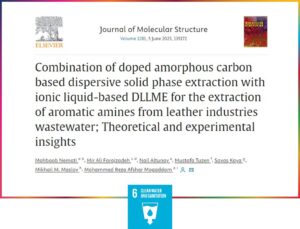
In a study, researchers have developed a novel method for the efficient extraction and detection of hazardous aromatic amines in wastewater from the leather industry, showcasing a significant stride toward environmental protection and sustainable industrial practices. This collaborative research, involving researcher Farajzadeh from Near East University, leverages an innovative combination of dispersive solid phase extraction and ionic liquid-based dispersive liquid-liquid microextraction techniques to address the pressing issue of contaminant removal from industrial effluents.
The heart of this approach lies in the utilization of nitrogen and sulfur-doped carbon as a sorbent for the initial adsorption of the target analytes from the wastewater samples. This step is crucial for isolating the hazardous compounds from a complex mixture. Subsequently, these adsorbed analytes are concentrated using a microextraction process that involves a small volume of an ionic liquid, which acts as the extraction solvent. This two-step process not only ensures the effective concentration of the analytes but also significantly reduces the volume of the sample needed for analysis.
High-performance liquid chromatography coupled with an ultraviolet detector (HPLC-UV) was employed for the quantification of the extracted aromatic amines, providing a sensitive and reliable detection method. Moreover, the study ventured into the molecular level interactions between the ionic liquids used in the microextraction process and the aromatic amines through density-functional theory (DFT) calculations. These insights into the chemical interactions further validated the efficacy of the selected ionic liquids in the extraction process.
The proposed method demonstrates several advantages including simplicity, rapidity, environmental friendliness, and cost-effectiveness. With limits of detection and quantification reaching as low as 0.25–0.71 ng/mL and 0.86–2.4 ng/mL, respectively, and high precision and recovery rates, this technique sets a new benchmark for the analysis of hazardous substances in industrial wastewater.
By successfully detecting compounds such as p–anisidine, p–chloroaniline, and diethylaniline in actual wastewater samples from leather manufacturers, this study not only presents a groundbreaking analytical tool but also underscores the critical need for adopting cleaner and more sustainable industrial practices. The integration of such advanced analytical methodologies can significantly contribute to environmental monitoring and protection efforts, offering a promising avenue for the mitigation of industrial pollution.
More Information:
https://www.sciencedirect.com/science/article/pii/S0022286023002727